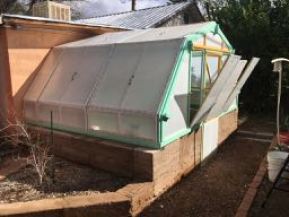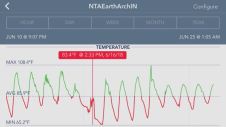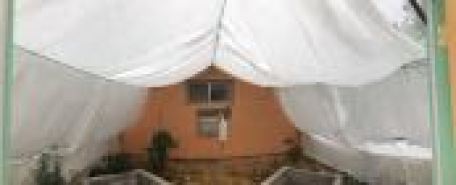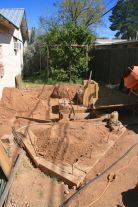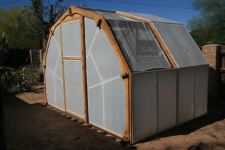I’ve kept records of rainfall since 2011. That was when I joined the Community Collaborative Rain, Hail and Snow (CoCoRaHS) network. CoCoRaHS is a unique, non-profit, community-based network of volunteers of all ages and backgrounds working together to measure and map precipitation. The premise is simple. When you join the network you purchase a rain gauge that is standard for the network ($48) at the Weather My Way online supplier. When you join you get an unique identifying numberfor your site. Each morning you check the gauge. Then you login to the CoCoRaHS website and enter the amount in a precipitation report. You can then view a map of all the other observers reporting rainfall in your area and entries from all the other volunteers in the network. You also get a water year report showing when you got rain (or hail or snow) and how much you reported on a specific date. This report also gives you the twenty year average for precipitation at your location. This connects you to a national data base supported by over 15,000 observers. It’s a great way to support citizen involvement in meteorology science.
In 2020 the National Weather Service recorded 4.17 inches for the year, the driest on record. It eclipsed the former record of 5.07 inches in 1924. Eleven miles north of the airport at my site I recorded 5.6 inches of rain for the year. The monsoon period (June -September) recorded only 1.67 inches for this period, granting it the moniker “the nonsoon.”
The contrast of 2020 with 2021 is stark. 2021 was the third wettest monsoon on record. The June to September total was 12.79 inches, a 7.10 inch departure from the normal monsoon rainfall of 5.69 inches. At my site precipitation was 11.27 inches. It is times like this that I could use three times the rainwater storage that I have now.
While I’m on the subject of meteorology, I was accepted as a speaker in the first ever American Meteorological Society Weather Band Symposium held on Zoom January 21-22, 2022. As a part of the process of designing the Nurse Tree Arch, I put together a 16 year picture of Tucson temperature ranges (reported at the airport) and rainfall reported from my CoCoRaHS gauge. In a narrated slide program I shared the resulting data about weather in an easy to understand picture of the temperature ranges. I explained that the weather picture helped me understand how to manage temperatures in my garden and the Earth Arch. You can find a small rendering of the temperature range graph below and the 15 minute slide program at YouTube: https://youtu.be/mLDp4VRd9N0
This brings me to the continual tests for the Nurse Tree Design. The five layers of protection provided by the Earth Arch are the Aluminet shade cloth, fast growing Pomegranite tree protecting the west side of the structure, hydrophobic row cover, polystyrene panels, fan and mulch. This combination allows me, the gardener, to customize the arch for the temperatures and weather extremes I encounter here in the Sonoran desert.

I’m harvesting tomato’s planted in March, 2021 in January, 2022. This is the result of getting sensitive tomato plants through the extreme heat and dryness of early summer, opening the arch to the third wettest monsoon on record, and then, as best I can, keeping the plants at a range of 50˚- 90˚ f. I do this by configuring the arch with a combination of Aluminet, row cover and fan through summer into the fall.
The data I collect comes from calibrated SensorPush HT1 Wireless Thermometer/Hygrometer cubes located inside and outside the arch ($50 each). The cubes are mounted inside La Crosse Technology 925-1418 Sensor Protection Shields with Mount ($19 each). In the middle photo is the CoCoRaHS rain guage available for $49 from Weather Your Way. On the right is the the Tempest Weather System from Weatherflow.

2021 Earth Arch Configured for Heat and Cold
The hottest day of 2021 was 116˚ on June 15. Ground temperatures outside the arch were in the 150˚range.
On June 15 the Earth Arch was configured with a 40% Aluminet cover, hydrophobic row cover curtains closed with venting at the top and the south side polystyrene windows open. The fan was on and pushing 86˚ f. air from inside the workshop into the arch. I
In contrast to the denser 75% weave I’ve used in the past this was an experiment with the more open 40% weave of Aluminet. The temperature inside the arch was 104.2 at 2:48 PM, 12˚ f. cooler than outside. Inside the soil was 80˚-85˚. The 75% kept the arch about 4˚ f. cooler than the 45% . Blossom drop was inevitable, but my purpose at this time of year is to keep roots, the microbial community and above ground tissue alive, so that I can get production in the fall and winter.
With temperatures in the 30˚ range this winter 2022 I supplement the arch with a small space heater to keep temperatures in the range needed to avoid blossom drop. On January 2nd the minimum reached 30.8˚ f. at 8:01 AM. Inside the Earth Arch with the heater assist, the temperature low was 39.9˚ f. The average temperature was 58˚inside compared with 50˚ f. outside. The temperature high inside the arch was 81.5˚at 2:27 PM. No blossom drop was observed.

















